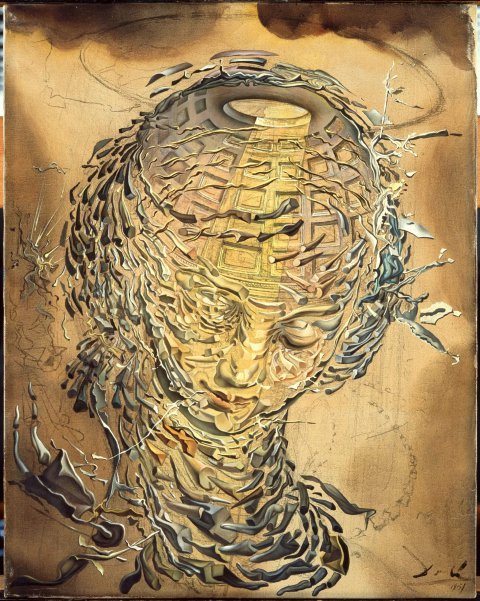
Raphaelesque Head Exploding was painted by Salvador Dali in 1951. At the same time his "Mystical Manifesto" was published, eloquently and declaratively testifying to the change in the artist's ideological and creative attitudes.
During the period of surrealism, as Dali said, he tried to portray the inner world of a person - the same one whose secrets were first discovered by Sigmund Freud. However, times have changed. The outside world of physics has broken free from the embrace of psychology, and then Dr. Heisenberg, according to Salvador Dali, was his new father.
Let's remind: the atomic bombs dropped on Hiroshima and Nagasaki in August 1945 became the harbinger of the nuclear-mystical period of Salvador Dali. The world of physics, which studies the smallest particles that make up matter, literally bewitched the painter.
From then on, he closely followed all the achievements of nuclear science, fixing them through painting. If physicists studied these tiny particles that make up everything that exists, why shouldn't an artist depict them?
Dali's nuclear-mystical approach to the artistic creation covered a variety of techniques - from fragmenting objects and recreating their molecular-structural accuracy to imitating the gelatinous viscosity of primary matter. In the most general sense, Dali now worshiped three gods: the great ancient and classical heritage of art, Catholicism in its Spanish mystical version and nuclear physics. All these "gods" are clearly represented in the painting "Raphaelesque Head Exploding".
The inner part of the head of the Raphael Madonna taken as the basis for Dali' painting is depicted in the form of the famous dome of the Pantheon (ancient art), the Virgin embodies the Catholic faith, and her fragmented image is a tribute to the luminaries of modern nuclear science.
It is also interesting to note that both the thin circle of the halo and the rather disturbing clouds that serve as the background in the picture, at the first glance, suggest the idea of a nuclear explosion - this was exactly the intention of Salvador Dali.
Again, Dali would not have been Dali if he had not filled his Exploding Head with many additional meanings. One of them is the continuity, expressed in the triad "Ancient Art - Renaissance -" "Divine Salvador Dali."
After all, what is the Pantheon? This is a unique masterpiece of architecture that has become a real breakthrough in construction science. And Raphael's Madonna? After all, this is not an abstract, sublimely incorporeal Madonna of the Gothic era, when God was great, but Man was less than nothing - no!
This Raphael's Madonna is much more earthly, the Madonna is down-to-earth, if you will, vulgarized - after all, when painting her, Raphael used, as a model his mistress, Margharita Luti known as "Fornarina" - that is, an earthly woman who, moreover, was his beloved one. Would Raphael have dared to do this if he had not lived so in the era of High Renaissance?
That is, Raphael's "down-to-earth" Madonna is a reflection of either the already happened or the upcoming irreversible changes in the perception of the world associated with great scientific discoveries. In other words, Raphael's Madonna is a reflection of scientific changes at the level of art. Copernicus with his heliocentric system is only one step away from Raphael's Madonna.
In the same way, the "Raphaelesque Head Exploding" is a reflection at the level of art of the achievements of modern Salvador Dali science, not only invading the everyday world, but also threatening to destroy it in a single atomic swing! The Cold War, among other things, exposed the fragility of the existence of mankind, which has received at its disposal a hitherto unseen nuclear power.
Of course, Dali "believes" in Catholicism in his own way. Very in its own way: after all, splashing sperm, like the accompanying identification of the Madonna with an ear of corn (a symbol of fertility), can by no means be attributed to the canonical iconography of the Madonna.
And the rhino horn, the cult of which, as you know, Dali has been obsessed with since the early 50s, is also a far from unambiguous symbol, due to its frankly phallic shape, which Dali especially appreciated in this rhinoceros appendage. But do we reallyss have the right to want from Salvador Dali the usual, "canonical" faith? (Read the original text in Russian)

The authors of the article are Sergei Zakharov and his wife, colleague and comrad-in-arms, Tatiana - writers and tour guides. You can learn more about our books and buy them in the "Where and what to read" section. We invite you to our tours of the Dali museums in Catalonia. Revealing secrets, debunking myths, telling the truth - we promise full and deep immersion in the amazing Universe of Salvador Dali!




Write a comment